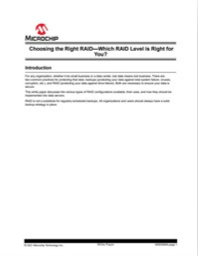Choosing the Right RAID—Which RAID Level is Right for You?
For any organization, whether it be small business or a data center, lost data means lost business. There are two common practices for protecting that data: backups (protecting your data against total system failure, viruses, corruption, etc.), and RAID (protecting your data against drive failure). Both are necessary to ensure your data is secure. RAID is not a substitute for regularly-scheduled backups. All organizations and users should always have a solid backup strategy in place.
This white paper discusses the various types of RAID configurations available, their uses, and how they should be implemented into data servers.
Read More
By submitting this form you agree to Microchip contacting you with marketing-related emails or by telephone. You may unsubscribe at any time. Microchip web sites and communications are subject to their Privacy Notice.
By requesting this resource you agree to our terms of use. All data is protected by our Privacy Notice. If you have any further questions please email dataprotection@techpublishhub.com
Related Categories: AIM, Applications, Backups, Cloud, Connectivity, Data Center, Data Storage, Databases, Email, ERP, Hardware, Linux, Operating System, RAID, SAN, Server, Software, Storage, Storage Devices


More resources from Microchip

BlueSky™ Performance Monitoring
This document describes how BlueSky™ Performance Monitoring delivers a solution for monitoring GNSS Observables and characterizing live-sky GNSS ...

Choosing the Right RAID—Which RAID Level is...
For any organization, whether it be small business or a data center, lost data means lost business. There are two common practices for protecting t...

Top Ten Tips When Buying A Raid Adapter
RAID (Redundant Array of Inexpensive Disks) is a data storage structure that allows a system administrator and others to combine two or more physic...